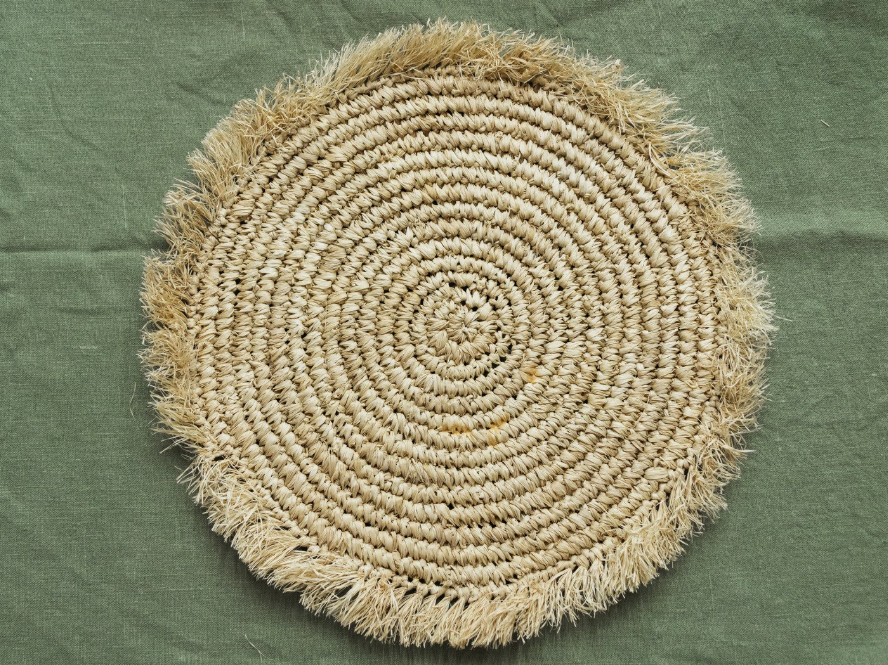Making your own jute rugs will bring together the pleasure of making something gorgeous using your hands, and the pleasure of incorporating sustainable natural, organic materials to your house. Jute with its earthy texture and strong fibers makes a perfect base for hand-woven flooring coverings that will make any space look more rustic and beauty.
It doesn’t matter if you’re drawn to DIY projects due to their artistic satisfaction or are looking for eco-friendly alternatives to mass-produced decor weaving carpets made of jute can provide unlimited possibilities to customize. You are in control of each aspect of your design, from the size and color to the patterns and texture, all while using one of nature’s finest fibers.
This complete instruction can walk you through each stage of the jute rug weaving process, starting with selecting the materials you want to use before setting your weaving loom up until adding the perfect finishing elements that make your work completely yours. When you’re done you’ll have the necessary information to design beautiful, custom flooring that reflects your individual design and style.
Understanding Jute and Weaving Basics
Jute comes from the jute stem plant, which is mostly used across India in India and Bangladesh. The fine, golden fibre has been utilized for many centuries in rope-making sacking and in textile production due to its incredible strength and biodegradability. In the field of making rug, the jute provides many compelling advantages, making it the ideal material for crafters at home.
The tensile strength of jute fibers will ensure that the hand-woven piece will stand up to the rigors of daily use while preserving its shape. The natural golden-brown color creates an earthy, warm foundation which is perfect for various designs for interiors, ranging from bohemian, farmhouse to contemporary. The most important thing is that Jute is environmentally sustainable because it’s biodegradable, and requires minimal processing in comparison against synthetic substitutes.
In the jute rug weaving process there are three main weaving techniques. Plain weave is the most simple pattern in which threads of weft pass through and under each other, the warp threads in a series of alternating. Twill weave results in diagonal patterns that provide visual interest and increases the durability. Braided weave involves plaiting Jute yarns, creating an attractive casual look that is perfect for entrance rug.
Materials and Tools for Your Jute Weaving Project
The success of weaving jute rug starts by acquiring the proper material and equipment. The primary materials you will need are rope, jute yarn or cord. These are that is available in a variety of thicknesses based on the desired texture. Jute with a higher density gives a robust, rustic appearance, while more fine jute provides smoother, more refined surface.
A loom is the core of your weaving system. Frame looms are great for smaller projects and beginners and floor looms provide greater flexibility for larger rug. If you don’t think buying a loom would be practical, you could make an inexpensive DIY version by using an sturdy wooden frame as well as pegs or nails to secure those warp threads.
Other tools that are essential include a shuttle or a weaving needle to pass threads of weft through the warp and sharp scissors for cutting yarn and measuring tape to ensure exact measurements. Think about rug backing material for additional stability. Additionally, protective gloves are helpful if you find the texture of jute to be too rough for your hands when you are engaged in long weaving sessions.
Setting Up Your Loom for Success
A well-planned loom setup provides the groundwork for uniform professional outcomes. Start by making your warp threads – they run lengthwise and form the structure of your rugs. Although you could make use of jute throughout the project, a lot of weaver prefer linen or cotton warp threads due to their durability and strength and prefer jute as the weave.
Determine the number of threads you require based on your desired rug’s size and the distance you wish to leave between threads. Generally speaking, spacing warp threads around 1/4 inch apart will work for the majority of Jute rug designs. Thread each warp thread through your loom, ensuring consistent tension throughout all threads. Uneven tension can lead to an uneven, warped product.
You can test the tension of your thread by pressing gently on the middle of the warp threads. They will feel taut and firm but not too tight that they could snap when pressure is applied. Make adjustments as necessary prior to beginning the weaving process.
Step-by-Step Jute Rug Weaving Process
Step 1: Planning Your Design
Before you thread the first pass make sure you make a detailed plan of your design. Make sure to measure the area you intend to use to determine the best rug size, bearing the fact that handwoven rug can differ from the initial measurements because of the nature of the work.
Choose if you would like an uncolored rug, striped patterns or other variations on textural. Draw your plan on paper, jotting down the areas where pattern or color shifts will take place. This step helps avoid errors and makes sure you have the right materials for your entire design.
Step 2: Starting the Weave
Thread your shuttle using yarn made of jute leaving a 6-inch length which you’ll weave into the rug. Start with your initial pass by threading your shuttle between warp threads beginning between one end and another. Don’t be too loose in the first row. You’ll modify tension while you progress through your weave.
In the second pass you will reverse the over-under pattern. If you crossed one warp thread in the first pass then go under it in the next pass in reverse, and reverse the process. The alternating pattern forms the fundamental plain weave structure which will be the rug’s base.
Step 3: Building the Body
Consistency is essential as you construct the rug’s body. Keep a consistent tension throughout your weft threads. Too loose and your rug could become loose and fragile If it is too tight, it’ll pucker and disform. Each weft row should be firmly packed against the previous row with your fingers or with a fork-like tool however, avoid over-compression which can result in your rug becoming stiff.
This stage is the ideal occasion to introduce designs with different styles. Alternate between different thicknesses to create interest in the textural aspect or mix natural dyed jute yarns to create subtle changes in color. Keep in mind that jute can take natural dyes wonderfully and you can make colored yarns in advance with natural dyes such as indigo, turmeric, as well as madder root.
Step 4: Securing the Edges
When you are nearing the length you want for your rug Begin with the process of preparing your edge. Edges of handmade rug require extra care to ensure that they don’t unravel in time. Simple overhand knots are good for basic edge securing however, hemstitching provides more professional, polished appearance.
To hemstitch, tie several warp threads and tie them by wrapping tightly with the weft yarn. This technique will not only stop unraveling but also provides a stunning design element to the border of your rug.
Step 5: Adding Finishing Touches
Remove your rug from the loom with care while maintaining tension while cutting your warp threads. Make sure you leave enough length on both ends to accommodate the finishing method you choose. Typically, it’s 6 inches for the majority of edge treatment.
Cut off any uneven or loose fibers, but do not trim too much, as jute’s natural texture creates a rustic look. If you want, add backing material to increase toughness and stability, especially in rugs designed for high-traffic areas.
Customization Options for Your Jute Rugs
The appeal of hand-weaving is the ability to customize it completely. Change the size of your rug to suit specific areas by altering how many warp threads you weave and increasing the length of your weaving. Room-sized rugs are typically 8×10 feet. Handwoven pieces can be designed to any size that the space demands.
The possibilities for pattern and color expand exponentially when you play around with natural dyeing methods. Jute easily accepts plant-based dyes, which allows you to create earth-toned subtle shades or vibrant jewel colors based on the design preferences of your interior. Try dye baths with onion skins to create gold-colored yellows and avocado pits to create soft pinks or black beans to create deep blues.
Edge and border finishes greatly influence the look of your rug. The fringed edges give off relaxed, bohemian-style vibes that are ideal for spaces that are relaxed. Bound edges create sleek, refined looks that are suitable for formal settings. Borders with braided edges add interest and provide extra durability in high-wear zones.
Variations in texture keep your weaving fascinating and add visual depth. Variate the density of your weave by packing sections of your weave tightly while making some looser. Include different jute thicknesses in one piece or incorporate accessories like tassels, ornamental stitching or even woven-in leather strips to create a unique design.
Essential Tips for Successful Jute Weaving
Jute weaves present new challenges that skilled weavers can overcome. The roughness of the fiber may cause strain to the hands in long weaving sessions. Regularly take breaks, rotate your wrists and hands and think about wearing lightweight gloves in the event of irritation.
Jute naturally sheds tiny fibers during weaving which create what is known as “jute fuzz.” The amount of fuzz shed decreases dramatically after your rug is finished and has been in use for a period of time. While weaving, clean off excess fuzz often to ensure clear visibility of the work.
To maintain a consistent tightness in your weave, you need the practice and focus. Find a rhythm to your weaving movements and then take a step back to evaluate your work’s consistency. Little imperfections can add charm however, significant differences can alter the rug’s performance and look.
Caring for Your Handwoven Jute Rugs
A proper care regimen can extend your rug’s life span considerably. Vacuum frequently using an attachment for a brush to get rid of debris and dirt that could get on the jute fibers to lead to premature wear. Beware of using beater bars as they could cause damage to the natural fibers and cause damage to the weaving.
Jute’s primary adversary is moisture. Make sure your rugs are kept away from areas with high humidity and clean up spills promptly by blotting them out with dry, clean cloths. For more thorough cleaning professional services that are familiar with natural fiber rugs are the most secure option.
Keep jute rugs in a flat place for storage when not in use or roll them up with the pile facing forward. Avoid folding, as it could cause permanent wrinkles on the natural fibres. Cedar blocks or lavender sachets help deter insects during long-term storage.
Frequently Asked Questions
How long does it typically take to weave a jute rug?
A small 3×5 foot rug typically requires 15-25 hours of weaving time, depending on your experience level and design complexity. Larger rugs can take 40-60 hours or more.
What are the best methods for cleaning and maintaining a jute rug?
Regular vacuuming with a brush attachment, immediate spill cleanup by blotting, and annual professional cleaning for high-traffic rugs work best. Avoid soaking or steam cleaning.
Can I dye jute yarn at home, and if so, what dyes are recommended?
Yes, jute accepts natural plant-based dyes beautifully. Try turmeric for yellow, indigo for blue, madder root for red, or black beans for purple tones.
Are jute rugs suitable for high-traffic areas?
Jute’s durability makes it excellent for moderate to high-traffic areas. Adding backing material increases stability for heavy-use zones.
What is the best way to prevent a jute rug from slipping on hardwood floors?
Use natural rubber rug pads specifically designed for hard floors. Avoid PVC-based pads that can discolor natural fibers.
How can I customize the size and shape of my DIY jute rug?
Adjust loom width and weaving length for rectangular rugs. For round rugs, use circular looms or weave strips that you’ll sew together in a spiral pattern.
Where can I purchase high-quality jute yarn and weaving supplies?
Craft stores, online retailers, and specialty weaving suppliers offer various jute options. Look for suppliers who specify the jute’s origin and processing methods.
Are there any health benefits associated with using natural jute fibers in home décor?
Jute is naturally antimicrobial and doesn’t off-gas chemicals like synthetic materials. It also helps regulate indoor humidity levels.
Can I use jute rugs in humid environments without causing damage?
While jute tolerates normal humidity levels, avoid bathrooms or other consistently high-moisture areas where mold or mildew might develop.
How do I choose the right weaving style for my desired rug texture and pattern?
Plain weave offers versatility and ease for beginners. Twill weave creates more interesting visual patterns. Braided weave produces the most textural variation.
Start Your Jute Weaving Journey Today
Making your own jute rugs transforms natural fibers from the ground into beautiful and functional interior decor that is reflective of your individual design and environmental beliefs. The relaxing pattern of weaving, along with the satisfaction of making something that is completely yours creates a craft that is both relaxing and satisfying.
Keep in mind that every skilled weaver started out as a beginner. Your first rug may be imperfect These imperfections add to the handmade appeal and also provide invaluable learning opportunities for future projects. Every rug you make will demonstrate improvement in your the technique as well as confidence.
Are you ready to begin with your weaving adventure? Explore The Ambiente’s selection of high-quality handmade jute rugs for ideas and inspiration. Create your own jute rugs project today using high-end weaving tools Don’t forget to show off your DIY Jute Rug creations on social media with the hashtag #DIYJuteRugs. Join our newsletter to receive additional weaving tutorials as well as interior decorating tips to aid you in your craft journey.





